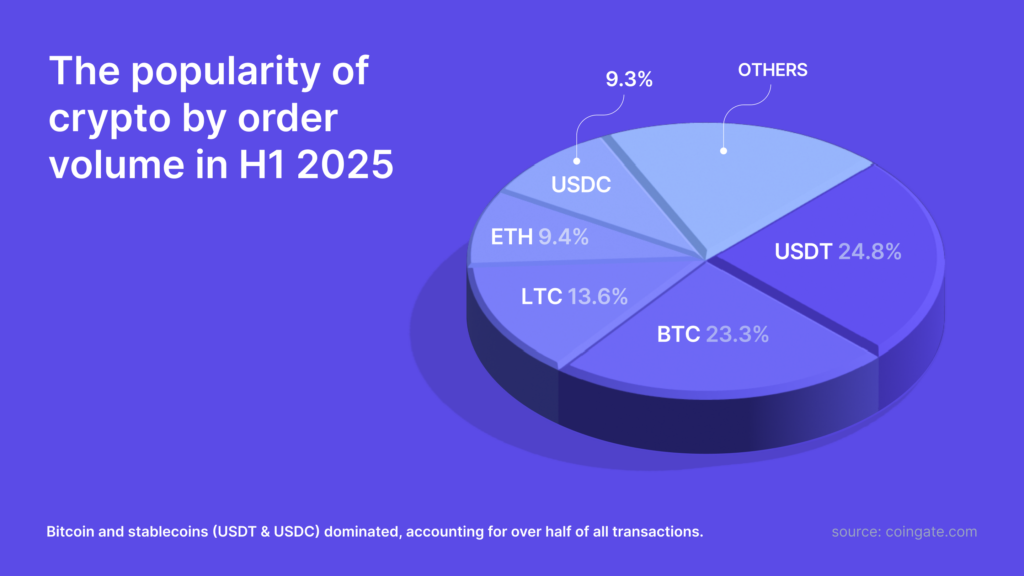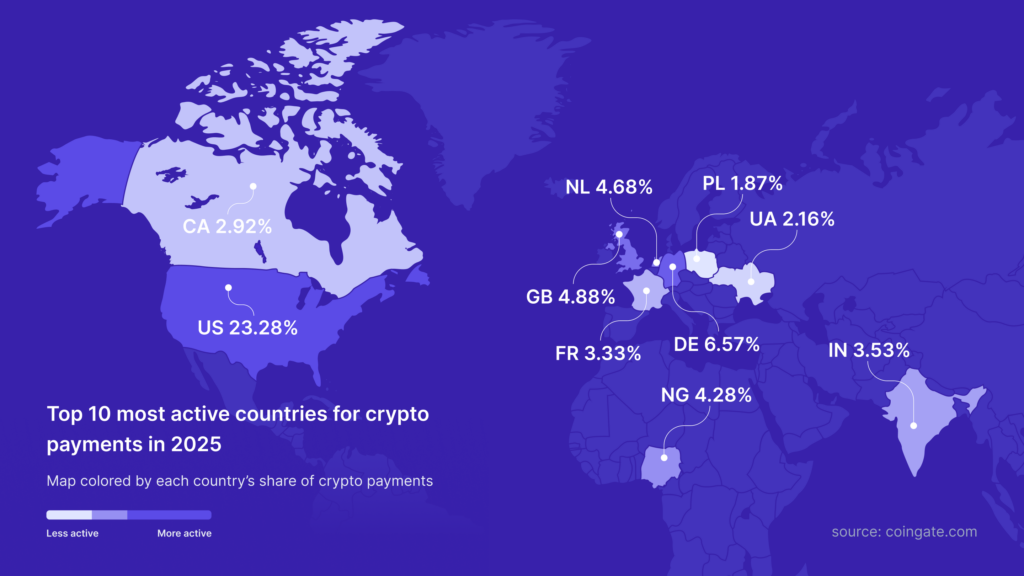
Insights & Trends of Crypto Payments Around the World in 2025

Crypto payments have come a long way and the global story is far from uniform.
While some countries double down on Bitcoin, others embrace stablecoins or niche altcoins. To understand what’s really happening on the ground, we’ve taken a closer look at CoinGate’s checkout data across key regions and individual countries.
In this report, we break down these regional trends to help merchants understand what customers are paying with – and how to meet them where they are.
Brief Crypto Payments Overview (2023–2025)
In 2023, Bitcoin dominated crypto checkouts with a 35.4% share, while USDT held 25.5%.
However, 2024 pushed shoppers towards stablecoins. USDT surged to 39.7%, while BTC dropped to 21%.
Halfway through 2025, Bitcoin rebounded slightly to 23.3%, and USDT settled at 24.8%. Litecoin emerged as a consistent favorite, reaching 13.6%, followed by Ethereum (9.4%) and USDC (9.3%).

Find the in-depth analysis of different time periods below:
Regional Insights Show Different Preferences Across the Globe
Over the past two and a half years, we’ve seen subtle but telling shifts in both the top cryptocurrencies used at checkout and the most active countries using crypto payments.
Most Used Cryptocurrencies: Orders Then vs Now
| Rank | 2023 | 2024 | H1 2025 |
| #1 | BTC 35.4% | USDT 39.7% | USDT 24.8% |
| #2 | USDT 25.5% | BTC 21.0% | BTC 23.3% |
| #3 | LTC 9.5% | LTC 12.1% | LTC 13.6% |
| #4 | ETH 9.3% | TRX 8.4% | ETH 9.4% |
| #5 | TRX 7.2% | ETH 8.2% | USDC 9.3% |
Key takeaways:
- Bitcoin lost its top spot in 2024 but is regaining traction in 2025.
- USDT peaked in 2024 and then declined sharply due to MiCA restrictions in Europe, while a compliant alternative, USDC, entered the top five in 2025.
- Litecoin consistently grew over the years – up from 9.5% in 2023 to 13.6% in 2025.
- TRX dropped out of the top five by 2025, replaced by USDC for the first time.
Most Active Countries by Share of Crypto Orders
| Year | Top 5 Countries |
| 2023 | USA (21.3%), DE (6.6%), GB (5.7%), NL (5%), NG (4.6%) |
| 2024 | USA (22.1%), DE (6.5%), GB (5.5%), NG (5.2%), NL (4.6%) |
| H1 2025 | USA (23.2%), DE (6.57%), GB (4.88%), NL (4.68%), NG (4.28%) |
Key takeaways:
- The United States maintained its #1 position and grew its lead slightly each year.
- Germany remained the #2 country, holding a steady ~6.5% share.
- The U.K., Netherlands, and Nigeria rounded out the top five each year, though their relative shares have slightly declined or plateaued.
- India and Canada began climbing in 2025, each moving into the top 8 globally.

| Region | Shoppers’ #1 Coin (H1 2025) | Surprise Statistic |
| North America | BTC 40% (US) | 54% of all global Lightning-network purchases originate in the US |
| Europe | USDT 22–50% (DE, UA) | Germany alone accounts for 9% of global TRX orders, 6% of all USDC orders, and 8% of LTC orders. |
| Asia | USDT 43–69% (IN, HK) | India now creates 6.1% of all USDT orders worldwide, almost double 2023. |
| Africa | USDT 23% (NG) | Nigeria punches above its weight: 8% of all BNB orders and 7% of SHIB orders come from NG. |
| Oceania | BTC 30% (AU) | Australia generates 7% of all POL orders, a token barely visible elsewhere. |
| LatAm | USDT 20% (BR) | Brazil’s Solana moment: 14% of global SOL orders in 2024, before cooling to 2% in 2025 H1. |
North America – Dominated by Bitcoin and Lightning
The US remains the largest crypto-shopping market, making up 23.2% of all global orders in 2025.
Bitcoin is by far the top choice here, used in 40% of purchases. Litecoin (13%), USDT (12%), Ethereum (11%), and USDC (9%) also play key roles.
The U.S. is also the global leader in Lightning Network usage — more than half (54%) of all Lightning transactions come from American shoppers. Canada follows a similar pattern but also leans heavily on Ethereum, with a 17% share.
Europe – Different Countries, Different Coins
Europe shows a wide mix of preferences. Germany has shifted from a Bitcoin-heavy country (32% in 2023) to a nearly even split between USDT (22%) and BTC (21%) in 2025, largely due to low fees on the TRON network.
In the UK, Bitcoin is still dominant at 28%, but Ethereum and USDC together now make up more than 20% of checkouts.
The Netherlands has an even split between BTC (24%) and USDT (23%), but also sees notable activity from DOGE and TRX, each accounting for 6% of orders.
Asia – Strong Stablecoin Preference
Asia strongly favors stablecoins, especially USDT. In India, USDT makes up 43% of all crypto purchases, and the country now generated over 6% of USDT transactions worldwide in 2025 — nearly double what it did in 2023.
Hong Kong shoppers used USDT for 69% of orders in 2024, although this dropped to 50% in early 2025.
Japan is more balanced, with a 2025 split of USDT (30%), TRX (16%), BTC (14%), USDC (11%), and ETH (9%).
Singapore stands out for its high-value purchases — despite contributing only 1% of global orders, it accounts for 6% of global transaction value.
Africa – Nigeria’s Shift Toward Altcoins
Nigeria has moved away from USDT, which dropped from 45% in 2024 to 23% in 2025.
Litecoin has gained popularity (22%), along with USDC (10%). Nigerian shoppers prefer cheaper networks like BSC and TRON.
Interestingly, Nigeria is also a key market for niche coins — it accounts for 8% of all global BNB orders and 7% of all SHIB transactions.
Oceania – Small Market, Distinct Preferences
Australia contributes just 1.2% of global crypto purchases but shows strong preferences.
Bitcoin is the most used (30%), followed by USDT (23%) and Litecoin (22%).
Australia also leads in use of the Polygon (POL) token, generating 7% of all global POL payments — a much higher share than any other country.
Latin America – Brazil’s Solana Boom (and Bust)
In 2024, Brazil became a hotspot for Solana, handling 14% of all global SOL purchases. But by mid-2025, SOL’s popularity dropped to just 2%.
Today, Brazilian shoppers mostly use USDT (20%) and USDC (15%) for crypto payments.
Network-Level Shifts and Layer-2 Momentum (H1 2025)
While Bitcoin and stablecoins often grab headlines, the real story of crypto payments also lives at the network level.
In H1 2025, CoinGate data shows a reshuffling of dominant blockchain networks used at checkout.
Bitcoin reclaimed the lead, driven in part by declining USDT activity on TRON, while Ethereum Layer-2 networks began rapidly scaling up thanks to growing USDC adoption.
Top 5 Blockchains by Transaction Share (H1 2025)
| Network | Share of Crypto Payments | Key Insight |
| Bitcoin (BTC) | 23.3% | Regained top position due to drop in TRON’s USDT dominance |
| TRON (TRC-20) | 21.6% | Declined under regulatory pressure and reduced USDT usage |
| Litecoin (LTC) | 13.6% | Maintained steady demand as a low-fee alternative |
| Ethereum (ETH) | 13.5% | Slight dip as users moved to cheaper alternatives |
| Binance Smart Chain (BSC) | 12.0% | Held firm thanks to low fees and ease of use |

Layer-2 Networks are Getting Traction
| Network | Highlight |
| Polygon | 117% increase in transactions vs full year 2024, fueled by USDC growth |
| Base | Launched Feb 2025; 59% of its transactions already involve USDC |
| Arbitrum | Over 9% of all USDC payments now occur on Arbitrum |
| Solana | Continued steady adoption despite temporary fee-related drop in Brazil |
| Optimism | Gained traction in both USDC and ETH payments |
Merchants that support these fast-rising Layer-2 solutions will be well-positioned for the future, especially in regions where stablecoin transactions dominate.
Supporting networks like Base, Polygon, and Arbitrum is becoming less of a competitive advantage and more of a necessity.
Altcoins and Memecoins: Steady Interest
Litecoin is notable for continuous growth from 9.5% in 2023 to 13.6% in 2025, making it the only major coin with uninterrupted gains.
Solana briefly peaked in Brazil but remains strong in the US, accounting for nearly a quarter of American SOL orders.
Memecoins like DOGE and SHIB are most popular in the US (31% and 39% respectively), with Nigeria emerging as a significant market.
Actionable Steps for Merchants
To align with global crypto trends and maximize conversions, merchants should:
- Add TRC-20 and BEP-20 support for USDT (except in the EU as it’s not supported) to cover 80% of Tether buyers. Polygon and Arbitrum can provide an additional 10% with minimal effort.
- Enable Litecoin – popular for its consistently low fees across major markets, especially in Nigeria, Germany, and the US
- Activate Bitcoin’s Lightning Network support, particularly for high-value transactions in North America and Europe, proven to boost conversion rates.
- Localize crypto payment options, emphasizing regionally favored coins like SOL in Brazil, USDC and SOL in India, and POL in Australia.
- Stay aware of emerging Layer-2 networks such as Base and Arbitrum, now handling over 10% of ETH and USDC transactions, to future-proof payment infrastructure.
CoinGate has you covered in all of these aspects. Ready to attract crypto spenders to your business? Sign up for an account today.
Looking Ahead: Second Half of 2025 and Beyond
Expect intensified competition among stablecoin networks, with transaction fees anticipated to drop due to technologies like Polygon CDK and Optimism’s Superchain. This will empower customers to switch networks based on costs dynamically.
Bitcoin’s Lightning Network is expected to match stablecoin simplicity soon with the BOLT 12 protocol upgrade, potentially boosting Bitcoin’s checkout share by the end of 2025.
Lastly, Base could quickly become dominant for USDC transactions, especially with Coinbase Commerce adopting Base as their default USDC payout network, potentially surpassing Polygon in popularity.
Keeping an eye on these trends will enable merchants to offer efficient, appealing crypto payment options to their global customer base.
Accept crypto with CoinGate
Accept crypto with confidence using everything you need in one platform.

